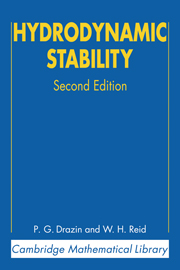Book contents
- Frontmatter
- Contents
- Foreword by John Miles
- Preface
- 1 INTRODUCTION
- 2 THERMAL INSTABILITY
- 3 CENTRIFUGAL INSTABILITY
- 4 PARALLEL SHEAR FLOWS
- 5 UNIFORM ASYMPTOTIC APPROXIMATIONS
- 6 ADDITIONAL TOPICS IN LINEAR STABILITY THEORY
- 7 NONLINEAR STABILITY
- APPENDIX: A CLASS OF GENERALIZED AIRY FUNCTIONS
- Addendum: Weakly non-parallel theories for the Blasius boundary layer
- Solutions
- Bibliography and author index
- Motion picture index
- Subject index
6 - ADDITIONAL TOPICS IN LINEAR STABILITY THEORY
Published online by Cambridge University Press: 06 August 2010
- Frontmatter
- Contents
- Foreword by John Miles
- Preface
- 1 INTRODUCTION
- 2 THERMAL INSTABILITY
- 3 CENTRIFUGAL INSTABILITY
- 4 PARALLEL SHEAR FLOWS
- 5 UNIFORM ASYMPTOTIC APPROXIMATIONS
- 6 ADDITIONAL TOPICS IN LINEAR STABILITY THEORY
- 7 NONLINEAR STABILITY
- APPENDIX: A CLASS OF GENERALIZED AIRY FUNCTIONS
- Addendum: Weakly non-parallel theories for the Blasius boundary layer
- Solutions
- Bibliography and author index
- Motion picture index
- Subject index
Summary
There can never be a last word in regard to the axioms of any physical theory. All we can ask of them is that they lead to conclusions in agreement with observation. Sooner or later more refined observations will find the weak point in any set of physical axioms. Nature is far too complicated to be completely described in a few equations.
– J. L. Synge (1938)Of the problems in the linear theory of hydrodynamic stability which have been solved, only a few have been presented in the previous chapters. These few were selected both to include the major results and to illustrate the fundamental ideas of the theory. A few more problems are treated briefly in this chapter, some to indicate the variety of the applications of the theory and others to cover more advanced topics.
Instability of parallel flow of a stratified fluid
Introduction
In Chapter 4 we developed the theory of stability of parallel flow of an inviscid fluid because it has direct applications and because it is fundamental to the theory of a viscous fluid. However, it is fundamental also to the theory of stability of parallel flow of an inviscid fluid under the action of external forces. There are many force fields important in diverse applications, but lack of space obliges us to confine our attention to a single external force, and we have chosen the force of buoyancy because it is as important as any for both theoretical developments and practical applications, notably to meteorology and oceanography.
- Type
- Chapter
- Information
- Hydrodynamic Stability , pp. 320 - 369Publisher: Cambridge University PressPrint publication year: 2004

